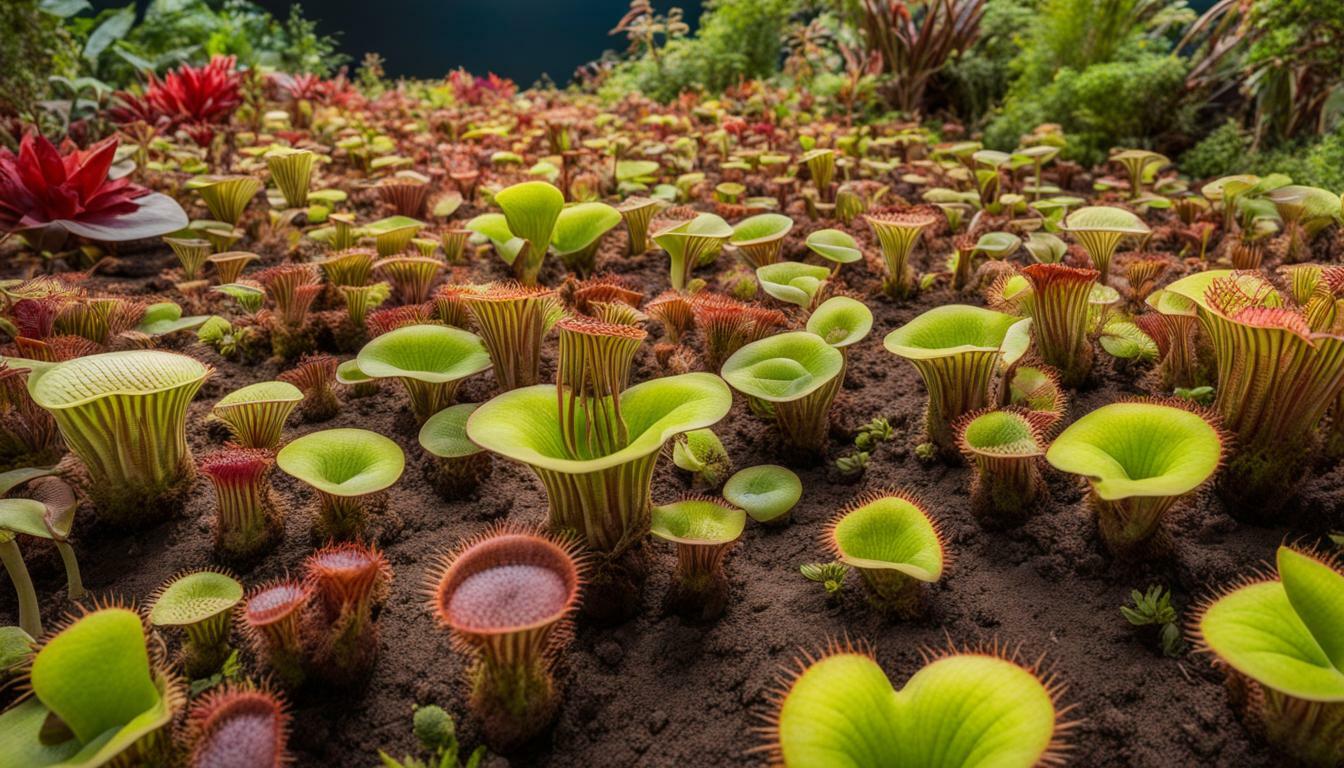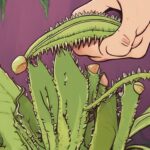If you’re fascinated by carnivorous plants, then Venus flytraps are likely high on your list of intriguing species. These unique plants are renowned for their ability to capture and digest insects, and they’ve fascinated botanists and enthusiasts for centuries. But did you know that there are different types of Venus flytraps? Each variety has its own unique traits that set it apart from the others.
In this article, we’ll explore the various Venus flytrap varieties, from the different species found in nature to the cultivated cultivars developed through selective breeding. We’ll also delve into the subspecies of Venus flytraps, which are variations within a species that have distinct characteristics or are geographically isolated. By the end of this article, you’ll have a greater understanding of the diverse world of Venus flytraps.
Key Takeaways:
- There are different types of Venus flytraps, including species, cultivars, and subspecies.
- Venus flytraps have unique traits that set them apart from other carnivorous plants.
- Understanding the various Venus flytrap varieties can help you appreciate the diversity of these intriguing plants.
Understanding Venus Flytrap Species
Venus flytraps, also known as Dionaea muscipula, are native to the eastern United States, particularly in the coastal plains of North and South Carolina. The species is divided into two distinct types: the typical Venus flytrap and the giant Venus flytrap.
The typical Venus flytrap is the most commonly found species and is identifiable by its small size and short, green leaves. The giant Venus flytrap, on the other hand, is much larger, with leaves that can grow up to 14 inches in length. It is also known as the “B-52” variety due to its large size.
Another notable species is the “red dragon” Venus flytrap, which is a cultivar of the typical Venus flytrap that features bright red coloring on its leaves. This cultivar is popular among collectors and enthusiasts.
Other species of Venus flytraps include the “cup trap” variety, which features shorter leaves with more defined cups for trapping prey, and the “waterfall” variety, which has longer, drooping leaves that reach towards the ground.
The Natural Habitat of Venus Flytrap Species
Venus flytrap species are only found naturally in the eastern United States, primarily in the coastal regions of North and South Carolina. They grow in nutrient-poor soils, such as those found in pine barrens and wet savannas, where they have adapted to survive by becoming carnivorous.
While Venus flytraps have been introduced to other parts of the world and can be cultivated in a variety of environments, they are best suited to their natural habitat and thrive in the conditions found in their native range.
Exploring Venus Flytrap Cultivars
If you thought Venus flytraps are fascinating, wait until you discover the world of cultivated Venus flytraps. Cultivars are developed through selective breeding, resulting in unique traits and appearances that set them apart from other varieties.
One of the most common cultivars is the ‘Dentate Traps.’ These cultivars have distinctly pointy traps, with teeth that resemble the serrated edge of a saw. They are known for their vigorous growth and ability to tolerate a wide range of temperatures, making them a popular choice among hobbyists.
Another popular cultivar is the ‘Red Dragon.’ As the name suggests, this cultivar has striking red coloration on the inside of its traps. The outside of the traps is green with red veins. This cultivar requires a lot of sunlight to maintain its color and is a favorite among collectors.
| Cultivar Name | Description |
|---|---|
| B52 | This cultivar is known for having oversized traps that can reach up to 2 inches in length. It is a vigorous grower, with vibrant green leaves. |
| Clayton’s Volcano | This cultivar features a unique shape, with traps that are curved and pointed upwards. Its color range from green to deep red, depending on how much sunlight it receives. |
| Cupped Trap | This cultivar has inward-curving traps that form a cup-like shape. Its color varies from green to red, and it is a relatively slow grower. |
Other cultivars, like the ‘B-52,’ ‘Clayton’s Volcano,’ and ‘Cupped Trap,’ have unique shapes and colorations that make them stand out. The B-52, for example, has oversized traps that can reach up to 2 inches in length, while the Clayton’s Volcano features upward-pointing traps with a range of colors from green to deep red.
Cultivated Venus flytraps are a testament to the impressive range of characteristics that can be produced through selective breeding. With so many different cultivars available, you’re sure to find one that catches your eye and piques your interest.
Uncovering Venus Flytrap Subspecies
Venus flytraps are not only diverse in their species and cultivars, but they also have different subspecies. Subspecies are variations within a species that have distinct characteristics or are geographically isolated. There are four subspecies of the Venus flytrap:
| Subspecies | Location | Description |
|---|---|---|
| Dionaea muscipula subsp. muscipula | Northern and Eastern North Carolina | The most common subspecies, known for its rapid trap closure and striking coloration. |
| Dionaea muscipula subsp. rubricorpora | Southern North Carolina and South Carolina | Has a darker coloration than other subspecies and produces smaller traps. |
| Dionaea muscipula subsp. venosa | Gibson Woods Nature Preserve in Mississippi | Only subspecies found outside of North Carolina and South Carolina. Has more veins on the traps and a different root system. |
| Dionaea muscipula subsp. trichocarpa | Outside of Wilmington, North Carolina | Has longer trap teeth and produces smaller traps than other subspecies. |
Understanding the different subspecies is important for conservation efforts. The Venus flytrap is considered a threatened and endangered species due to habitat loss and overcollection. By identifying and preserving the different subspecies, we can help protect the genetic diversity of the species as a whole.
The Ecological Importance of Venus Flytraps
Venus Flytraps are one of the most fascinating and iconic carnivorous plants in the world. These plants have evolved to be insectivorous, using their modified leaves to trap and digest their prey. But beyond their unique feeding habits, Venus Flytraps play an important role in their surrounding ecosystem.
First and foremost, Venus Flytraps help to control insect populations. By preying on insects, they help to keep the populations in check and maintain a healthy balance in the ecosystem. This not only benefits the plant, but also the other organisms in the surrounding area.
Additionally, Venus Flytraps have an important relationship with their habitat. They thrive in nutrient-poor soils, and their ability to obtain nutrients through their carnivorous diet allows them to survive in these otherwise inhospitable environments. By doing so, they help to support other plant and animal species that may struggle in these conditions.
Finally, Venus Flytraps are an important indicator species. Their presence can indicate the health of an ecosystem, as they only thrive in conditions that are conducive to their survival. By monitoring the Venus Flytrap population, researchers can gain insight into the state of the surrounding ecosystem and any potential environmental changes that may be occurring.
Overall, Venus Flytraps are not just a curious and intriguing plant, but also an important member of their ecosystem. Their unique adaptation for carnivory and their interactions with their habitat make them a valuable and important plant species to study and protect.
Conclusion
Congratulations! You now have a better understanding of the different varieties of Venus flytraps. From the various species found in nature to the cultivars developed through selective breeding and the subspecies that have distinct traits, Venus flytraps are truly a diverse group of carnivorous plants.
Remember, Venus flytraps play an important ecological role in their native habitats and are fascinating to observe in any setting. Whether you’re a plant enthusiast or simply intrigued by carnivorous plants, Venus flytraps are a must-see and learn about!
Is It Necessary to Water Different Varieties of Venus Flytraps Differently?
Watering different varieties of Venus Flytraps differently is essential for venus flytrap water care. Each variety has its own specific needs, and understanding these requirements ensures the health and vitality of these unique plants. Proper watering techniques can contribute to the overall thriving of the Venus flytrap and prevent any water-related issues that may arise. Proper venus flytrap water care is crucial for cultivating a successful and thriving Venus flytrap collection.
FAQ
Q: What are the different varieties of Venus flytraps?
A: Venus flytraps come in various types and varieties, including the typical variety, the red dragon variety, and the dente variety.
Q: What is the difference between Venus flytrap species?
A: Venus flytraps have different species that can be found in their natural habitats. These species may have distinct characteristics or variations, such as the Dionaea muscipula “typical” species and Dionaea muscipula “Akai Ryu” species.
Q: What are Venus flytrap cultivars?
A: Venus flytrap cultivars are cultivated varieties that have been selectively bred to develop unique traits and appearances. Some popular cultivars include “Bristle Tooth” and “Dentate Traps”.
Q: What are Venus flytrap subspecies?
A: Venus flytrap subspecies are variations within a species that have distinct characteristics or are geographically isolated. Examples of subspecies include Dionaea muscipula var. dentata and Dionaea muscipula var. trichterfalle.
Q: What is the ecological importance of Venus flytraps?
A: Venus flytraps play a crucial role in the ecosystem as carnivorous plants. They have adapted to attract, capture, and digest insects, contributing to nutrient cycling and maintaining the balance of the surrounding environment.










